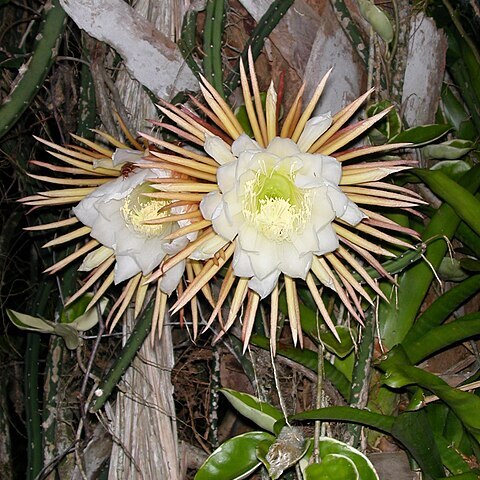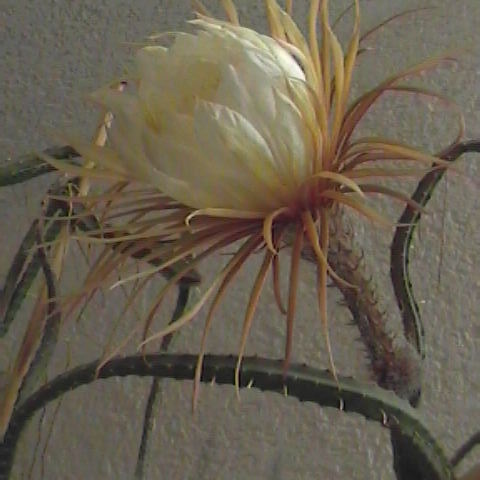Shrubs, vinelike, scandent, terrestrial, hemi-epiphytic, epiphytic, or epipetric, sparingly to abundantly branched, branches clustered at nodes. Roots diffuse or adventitious along stems. Stems segmented or unsegmented, usually bright green or bluish green to purplish, slender cylindric [flattened and leaflike in some epiphytic species], 100-500 × 0.8-5[-30] cm, glabrous; ribs [3-]4-8[-12] [or 2-winged in some epiphytic species], prominent and acute to low and rounded, rib crests straight to somewhat undulate [toothed, notched, or if stems winged and leaflike, then conspicuously lobed]; areoles [10-]15-25[-60] mm apart along ribs, small, orbicular, woolly with short white hairs, areolar glands absent; cortex thin and somewhat mucilaginous in thicker stems, pith usually not mucilaginous. Spines 1-18 per areole [absent on adult stems of epiphytic species], yellow, blackish, or brown [white, greenish, or reddish], lateral on stems, bristles hairlike, acicular, or conic, 1-15[-20] mm, soft to hard; radial spines [0-]1-18, straight to twisted, usually more slender and flexible than central spines; central spines [0-]1[-4] per areole, often not distinguishable from radials, straight [to bent], 1[-15] mm. Flowers nocturnal, lateral on stems, often fragrant, with long tube [tube essentially absent in S. innesii], funnelform to salverform, 12-40 × 8-20 cm; outer tepals usually widely spreading when fully open, yellow, orange, brownish, or greenish [to red or purple], linear to narrowly oblanceolate; inner tepals ascending to spreading when fully open, white [rarely colored], broad; areoles minutely scaly (scales absent in S. spinulosus) with hairs and bristles or spines; spines acicular or flexible, hairlike; stigma lobes 10-20, white to yellowish, usually long. Fruits usually red, spheric or oblong to ovoid, 5-9 cm, fleshy, hairs and bristles deciduous; scales, if present, minute, not conspicuous. Seeds black, ovoid to reniform, shiny. x = 11.
More
Shrubs, climbing, clambering or epiphytic, irregularly many-branched, plants to 10 m in length of more. Roots often adventitious along stem internodes. Stems segmented or unsegmented, 3-angled, ridged or winged, the segments elongate, green, often glaucous, glabrous, distinctly narrow proximally, the margins often horny. Areoles (10–) 35–50 mm apart along ribs, oval, woolly, with short hairs and fine spines. Leaves vestigial, at apex of stem, deciduous. Spines 0–4 (–8) per areole, acicular, bristly or hair-like or conic; radial spines (0) 1–18, straight to twisted, usually more slender and flexible than central spines; central spines (0) 1 (–4) per areole, often not distinguishable from radials, straight [to bent], 1–4 (–15) mm long. Flowers lateral to subterminal, funnelform to salverform, usually large, to 40 cm long, to 30 cm diam., usually nocturnal, often fragrant. Pericarpel and hypanthium stout, with broad triangular scales or scales minute (very rarely absent), naked or nearly so in the axils; pericarpal smooth to tuberculate, areoles spiny or spineless, with or without without hairs or wool. Outer tepals linear to narrowly oblanceolate, often greenish, yellow, pink, brownish, or occasionally purplish red or white, often widely spreading. Inner tepals ascending to spreading when fully open, white to cream (rarely pink or red). Stamens numerous in a continuous series. Style thick, stigma lobes sometimes bifid, white or pale yellowish. Fruits globose, oblong, ovoid, or ellipsoid, fleshy, covered with broad scales, with or without spines, irregularly dehiscent on 1 side, usually red, pulp white, often edible, floral remnants persistent or deciduous. Seeds elongate, pyriform or reniform, 2–3 × 1.5–2 mm, glossy black-brown, smooth or minutely textured; mucilage sheath present, covering entire seed.


